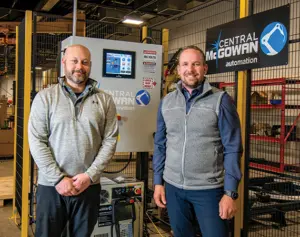As manufacturers wrestle with the persistent worker shortage, automation offers an excellent strategy to address the labor crunch while improving overall operations.
Companies new to automation, and those that have tried before and fallen short, can achieve success in a short time if they follow a process that includes three key actions: communicate, carry out, and cultivate.
Communicate. The process begins with communication — what automation is, the company’s goals for it, and how to determine specific automation targets.
Carry out. Taking quick action is critical for maintaining employee engagement. After stating goals and gathering input from employees, shift into trying different automation efforts as soon as possible.
Cultivate. As automation efforts are tried, share the results with employees and begin building a framework that extends beyond the initial automation activities.
Employee engagement at the center

Within these areas, employee engagement is both the most critical component and the most positive outcome of the process. It is so essential to the success of automation, that companies should spend some time before implementing automation to ensure employee engagement within the company is strong.
To boost engagement, leaders should give employees the skills and authority to recognize and initiate process improvement, which is precisely the aim of automation. Articulating the goals of the process, inviting employee input and acting on employee suggestions must be constant throughout implementation.
In addition, companies in the early stages of automation efforts typically find the most success and highest return on investment when they aim their first round of efforts at the shop floor level. That means operators are critical to the success of the initiative. They should be involved in identifying automation targets, trying alternatives, and evaluating results.
Engaging employees this way enhances automation efforts while improving overall operations. My colleague Ally Johnston, an Enterprise Minnesota business consultant, works with manufacturers to improve productivity, eliminate waste, and build a culture of continuous improvement.
Ally often cites data from a Gallup survey showing that companies in the top 25% for engaged employees have a remarkable edge over their competitors in measures including safety incidents, absenteeism, quality defects, productivity, and profitability. Engaging employees in automation can lead to these positive results while improving operations.
Take your continuous improvement journey to the next level. Find your local expert here and get started today.
Baseline communication
Before beginning an automation effort, companies should also review how they communicate with employees about all aspects of the company.
First, employees have to know the “why” of the company. That means engaging employees and building a strong commitment to their personal “why” and motivation.
They should also have a solid understanding of the organization’s “why” and motivation. In addition, employees need to understand what goals and expectations constitute a good day for the company. Make sure they have opportunities and venues to bring up issues they are facing, through huddles or communication boards, for example.
When operators have an outlet to provide suggestions and improvement ideas, and leaders consistently share thoughts on future growth and expansion, an atmosphere of trust emerges. An environment that includes these components of communication serves as fertile ground for automation efforts.
Establish goals
Next, companies can begin communicating directly about automation itself. That means clearly outlining the goals of automation, discussing the ongoing effects of automation, and, once available, sharing the results of automation efforts.
Automation can be scary to some employees. They might associate automation and robots with job replacement.
Leaders should convey their goals for automation, including the primary objective of improving the daily work life of employees by reducing physical demands, increasing collaboration among workers and increasing career opportunities for operators.
It is important to emphasize the long-term goals of the company, which likely include increasing the workforce. Through automation, companies can multiply productivity and increase the throughput they can achieve with the same workforce. Ultimately, most manufacturers want to increase their workforce as automation drives greater output and increased sales; this is a great goal to share with employees.
Another goal of automation — improving precision — happens because the outcome of an automated operation is exactly the same every time. This raises the importance of processes, which determine accuracy. With good processes, an automated operation will yield accuracy every time, so it is important to review processes in anticipation of automation efforts.
Identify automation opportunities
After reviewing goals, the next step is determining opportunities for automation. Three approaches are particularly helpful in this regard: polling employees, employing data analytics, and using “Learning to See” — the process used in building lean culture to determine if processes add value, don’t add value, or create waste in an operation.
Polling employees can be as simple as asking which tasks are least desirable and understanding why. Next, develop ideas to automate those tasks. Brainstorm and then “try storm” and take action.
Make sure employees see efforts to make their days better. The quickest way to lose employee engagement is to pull them in, ask for their input and then do nothing with it.
Data analytics involves using monitoring systems to help identify waste, and can be a great source of automation targets.
An example of this is a company I worked with that used a molding operation with four different arms. For every fourth arm, it would take a very long time to remove a particular part from the mold, but until the operation was monitored, it wasn’t clear exactly how much time was wasted.
Leaders found that three operators spent 45 minutes beating a part out of a mold because it was so badly stuck. They worked with the operators, soliciting their input on solutions. The result: The operators helped devise a hoist-based system to lift the part out of the mold. The process went from three operators removing the part in 45 minutes to one operator removing it in 10. That all resulted from analyzing data.
Finally, an excellent way to identify automation opportunities is by teaching operators to use the “Learning to See” process of identifying waste. Operations not done right the first time, or processes customers do not need or are not willing to pay for, are typically great targets for automation. “Learning to See” these losses improves overall operations and can help companies identify automation opportunities.
At Enterprise Minnesota, clients are taught the acronym DOWNTIME to identify wastes. Automation has the potential to help each of the wastes represented by the acronym: defects, overproduction, waiting, non-utilized talent, transportation, inventory, motion and extra processing.
“Learning to See” is a powerful tool for employee engagement. I worked with a group of employees recently, discussing this process of identifying those operations that add value, don’t add value, or count as waste.
Once the employees began to understand and see this waste within their own work cells, they went back to their work cells in between each individual meeting that we had with them to make changes. They were excited to help make a difference, and that’s the power in teaching these processes and engaging employees.
Always seek input
With a transparent communication process that involves all employees, automation builds excitement. Employees who are engaged in the process are perfectly positioned to offer excellent suggestions for automation targets as well as recommendations for improvements once automation is put in place.
A company I worked with recently uses robotic welding for a mainframe. The fixture used to hold the mainframe pieces together didn’t have a very solid mounting system, and caused significant variability in the way those pieces came together.
The employee who was working in the cell had some great ideas to make the fixture more consistent. He had never brought these up before, but once he was asked, he happily offered his suggestions.
This situation is common; most of the time, employees are more committed to making improvements within their work cell than anyone else. They have to live with the outcomes every day, so they are eager to share any suggestions that can result in a better process or make their lives a little better — or both — if they are asked.
Carry out quickly
Many companies will evolve in their automation journey, and eventually forms of automation from all levels of the pyramid will become evident throughout the organization. Manufacturers just beginning automation are best served by focusing on the lowest portions of the pyramid: the control and field levels.
Starting at the lowest level of the pyramid, companies can implement sensors, actuators, and other field level automation equipment. These are the lowest cost areas for automation and generate a significant return on investment.
Taking action quickly keeps employees engaged. Consider employee thoughts and ideas, and then get started. The most important thing is that employees feel heard.
Consider one low cost/high yield automation effort. A manufacturer had to send parts through a clean room before assembly. These parts traveled through a hot water bath on a conveyor, starting with the push of a button for each cycle.
Occasionally an operator would forget to hit the button or would start it too early, and that meant other operators wasted time waiting, or rushed to catch up.
An operator who was particularly annoyed with the variability and flow asked what could be done to automate this process. It turned out it was really quite simple to automate the wash with a PLC-based timer. The work cell became incredibly consistent and the belt turned on every 18 minutes. It just took input from the operator to make that change.
Involve operators in implementation
In addition to identifying opportunities for automation, operators must also be involved in carrying out automation plans. Leaders should develop a roadmap and communicate a plan of action as the effort moves along.
It’s important to keep in mind that shorter cycles increase engagement; operators can see things happening, and when they see change and progress, it will further interest them in engaging in the process and sharing additional ideas.
As companies begin trying different automation efforts, they should always try to fail cheap and fail often. Failing cheap means analyzing alternatives and looking into what could go wrong. These automation attempts should not be high risk to the organization, or to customers in terms of quality.
Failing often is good because it means a company is trying many solutions. The key is learning from those outcomes. Manufacturers that keep trying and keep evaluating their results will find solutions, and those solutions will improve processes and boost profits.
Cultivate for future success
After trying different automation efforts — regardless of how successful they are — it’s essential to celebrate. To sustain the culture of employee engagement and to ensure operators will continue to look for and suggest automation ideas, share results and celebrate successes.
Whatever data is available, distribute it to employees. Show productivity increases, reductions in quality scrap rates, increases in first pass yields — whatever the metric used to assess the automation journey.
Celebrate based on the size of the accomplishment. Maybe it’s a pizza party for an idea that is tried, or a $25 gift card for a suggestion.
Ask for reactions — good and bad — and act on the reactions to make additional improvements. It’s not good enough to share data and celebrate successes. There have to be avenues in place to get better and to keep engaging employees in conversation.
Finally, as the company grows, the operators should too. Establishing rewards for their dedication to the effort will shed positive light on the automation effort.
Create a job title that differentiates those with a skillset related to operating and troubleshooting automation. Increase the pay scale for those with these skills. Adopt an incentive plan and set stretch goals.
To reward teams of employees, implement improvements in common areas such as restrooms or break rooms. Anything that can create a sense of excitement around what automation can do for the employees will help boost and maintain engagement.
Finally, reinvest to fill the capacity gained through automation. Continue looking for opportunities to automate. Invest in people and in the sales process to drive demand, and upgrade facilities. Above all, keep engaging employees at every step.



